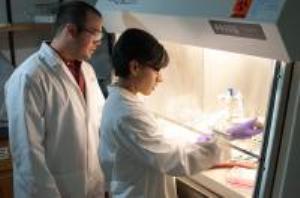Targeted drug delivery has gained popularity with development in nanotechnology. Researchers at the University of Georgia (UGA) have enhanced the process of direct drug delivery to targeted cells using nanoparticles to the next level where the drugs are delivered to a particular organelle in the targeted cells.
 Shanta Dhar, right, an assistant professor of chemistry in the UGA Franklin College of Arts and Sciences, and doctoral student Sean Marrache(credit John Paul Gallagher/University of Georgia)
Shanta Dhar, right, an assistant professor of chemistry in the UGA Franklin College of Arts and Sciences, and doctoral student Sean Marrache(credit John Paul Gallagher/University of Georgia)
The study was carried out by Shanta Dhar, assistant professor of chemistry at UGA and doctoral student Sean Marrache. The researchers enhanced the efficacy of mitochondria targeting drug therapies used in the treatment of Alzheimer’s disease, cancer and obesity.
Mitochondria, also known as the ‘powerhouse of cells’ is not easily accessible. The UGA researchers engineered nanoparticles from an FDA-approved biodegradable polymer and encapsulated the test drugs in them. The nanoparticles are synthesized in such a way that they deliver the drug right up to the mitochondria in the diseased cells. There are two membranes with an intermediary interstitial space protecting the mitochondria. The inner membrane allows molecules of a particular charge range alone to permeate while the outer membrane allows molecules of a particular size alone to pass through. The researchers developed a library of nanoparticles which were tested to identify the optimum size range (64 to 80 nm) and optimum surface charge (34 millivolts) of the nanoparticle that can penetrate the two membranes surrounding the mitochondria.
In order to test the efficacy of their drug delivery system, the researchers encapsulated the drugs corresponding to the treatment of Alzheimer’s, cancer and obesity in the engineered nanoparticles and treated the respective cultured diseased cells with the nanoparticles. It was found that the treatments using the nanoparticles that target the mitochondria are more effective than those that employ nanoparticles to deliver drugs outside the cell. The new method was much more effective in comparison to disease treatment with drugs sans nanoparticles.